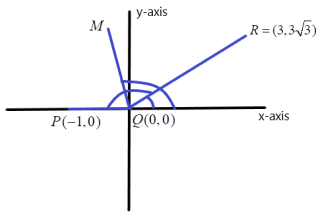
Let $P = ( - 1,0),Q = (0,0),R = (3,3\sqrt 3 )$ be three points. Then the equation of the bisector of the $\angle PQR$ is
A. $y = \sqrt 3 x$
B. $\sqrt 3 y = x$
C. $y = - \sqrt 3 x$
D. $\sqrt 3 y = - x$
Answer
218.7k+ views
Hint: In this question, we are given three points, to find the bisector of the angle formed by these three points we have to first find the angle formed by these three points, as $Q$ lies at origin, so we have to find the angle between line $PQ$ and $QR$ . As the point $P$ lies on the negative x-axis, so we will find the angle formed by $QR$ with x-axis by finding the slope of the line $QR$ , that can be easily found as the coordinates of the endpoints are given. Then we will find the angle that the bisector forms with the x-axis.
Complete step by step answer:

Image: The angle bisector of PQR
$
m = \dfrac{{3\sqrt 3 - 0}}{{3 - 0}} \\
\Rightarrow \tan \theta = \sqrt 3 \\
\Rightarrow \theta = 60^\circ \\
$
So, $QR$ makes an angle of $60^\circ $ with the x-axis, so we get:
$
\angle PQR = 180^\circ - 60^\circ \\
\Rightarrow \angle PQR = 120^\circ \\
$
Now, $QM$ is the bisector of $\angle PQR$ , so $\angle MQR = \dfrac{{120^\circ }}{2} = 60^\circ $
The angle that $QM$ makes with the x-axis is the sum of $\angle MQR$ and the angle that $QR$ makes with the x-axis, so it is $60^\circ + 60^\circ = 120^\circ $ .
Slope of line $QM = \tan 120^\circ = - \sqrt 3 $
Now, $QM$ passes through the origin, so using point slope from of line (that is $y - {y_1} = m(x - {x_1})$), we get:
$
y - 0 = - \sqrt 3 (x - 0) \\
\Rightarrow y = - \sqrt 3 x \\
$
The correct option is option C.
Note:
Angle bisector of an angle is defined as a line that divides that angle into two halves, that’s why we take $\angle MQR = \dfrac{{\angle PQR}}{2}$ . Equation of a line can be obtained by using various methods, as here only the slope and one passing point of the bisector line are given, so we used the point-slope form of the line.
Complete step by step answer:

Image: The angle bisector of PQR
$
m = \dfrac{{3\sqrt 3 - 0}}{{3 - 0}} \\
\Rightarrow \tan \theta = \sqrt 3 \\
\Rightarrow \theta = 60^\circ \\
$
So, $QR$ makes an angle of $60^\circ $ with the x-axis, so we get:
$
\angle PQR = 180^\circ - 60^\circ \\
\Rightarrow \angle PQR = 120^\circ \\
$
Now, $QM$ is the bisector of $\angle PQR$ , so $\angle MQR = \dfrac{{120^\circ }}{2} = 60^\circ $
The angle that $QM$ makes with the x-axis is the sum of $\angle MQR$ and the angle that $QR$ makes with the x-axis, so it is $60^\circ + 60^\circ = 120^\circ $ .
Slope of line $QM = \tan 120^\circ = - \sqrt 3 $
Now, $QM$ passes through the origin, so using point slope from of line (that is $y - {y_1} = m(x - {x_1})$), we get:
$
y - 0 = - \sqrt 3 (x - 0) \\
\Rightarrow y = - \sqrt 3 x \\
$
The correct option is option C.
Note:
Angle bisector of an angle is defined as a line that divides that angle into two halves, that’s why we take $\angle MQR = \dfrac{{\angle PQR}}{2}$ . Equation of a line can be obtained by using various methods, as here only the slope and one passing point of the bisector line are given, so we used the point-slope form of the line.
Recently Updated Pages
The maximum number of equivalence relations on the-class-11-maths-JEE_Main

A train is going from London to Cambridge stops at class 11 maths JEE_Main

Find the reminder when 798 is divided by 5 class 11 maths JEE_Main

An aeroplane left 50 minutes later than its schedu-class-11-maths-JEE_Main

A man on the top of a vertical observation tower o-class-11-maths-JEE_Main

In an election there are 8 candidates out of which class 11 maths JEE_Main

Trending doubts
JEE Main 2026: Application Form Open, Exam Dates, Syllabus, Eligibility & Question Papers

Derivation of Equation of Trajectory Explained for Students

Hybridisation in Chemistry – Concept, Types & Applications

Understanding the Angle of Deviation in a Prism

Understanding Collisions: Types and Examples for Students

Understanding Atomic Structure for Beginners

Other Pages
JEE Advanced Marks vs Ranks 2025: Understanding Category-wise Qualifying Marks and Previous Year Cut-offs

NCERT Solutions for Class 11 Maths Chapter 10 Conic Sections

NCERT Solutions for Class 11 Maths Chapter 9 Straight Lines

NCERT Solutions For Class 11 Maths Chapter 8 Sequences And Series

How to Convert a Galvanometer into an Ammeter or Voltmeter

NCERT Solutions For Class 11 Maths Chapter 12 Limits And Derivatives




